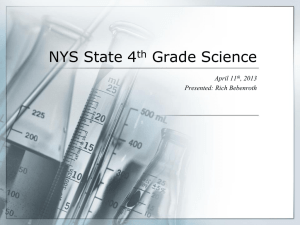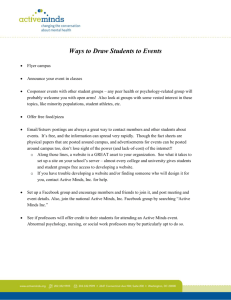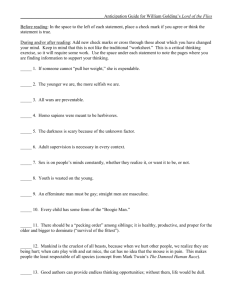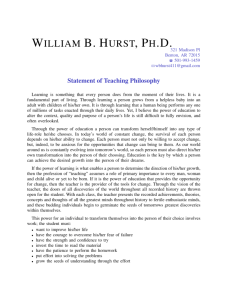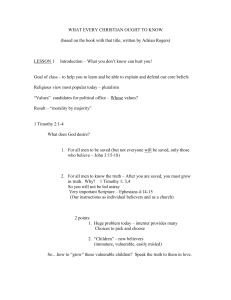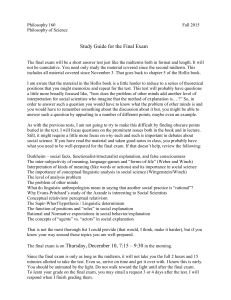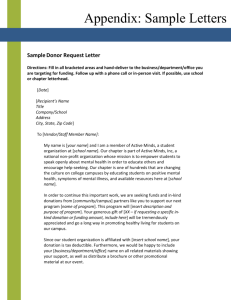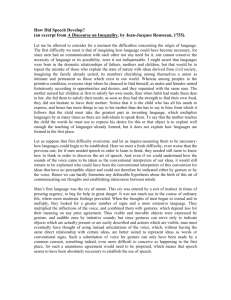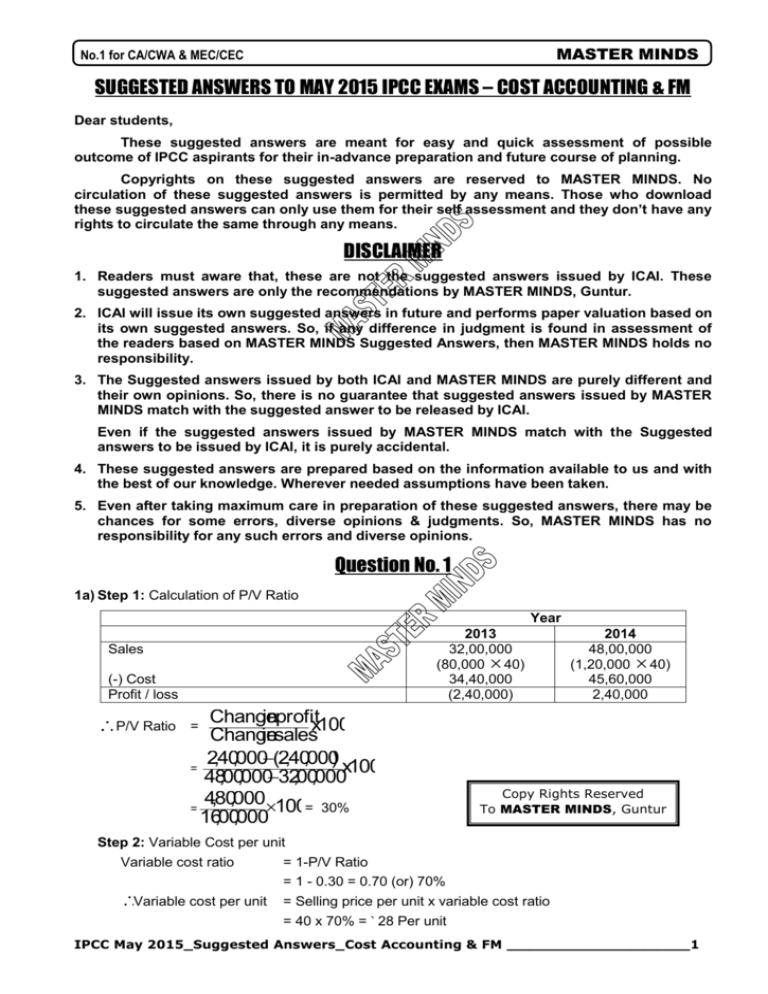
MASTER MINDS
No.1 for CA/CWA & MEC/CEC
SUGGESTED ANSWERS TO MAY 2015 IPCC EXAMS – COST ACCOUNTING & FM
Dear students,
These suggested answers are meant for easy and quick assessment of possible
outcome of IPCC aspirants for their in-advance preparation and future course of planning.
Copyrights on these suggested answers are reserved to MASTER MINDS. No
circulation of these suggested answers is permitted by any means. Those who download
these suggested answers can only use them for their self assessment and they don’t have any
rights to circulate the same through any means.
DISCLAIMER
1. Readers must aware that, these are not the suggested answers issued by ICAI. These
suggested answers are only the recommendations by MASTER MINDS, Guntur.
2. ICAI will issue its own suggested answers in future and performs paper valuation based on
its own suggested answers. So, if any difference in judgment is found in assessment of
the readers based on MASTER MINDS Suggested Answers, then MASTER MINDS holds no
responsibility.
3. The Suggested answers issued by both ICAI and MASTER MINDS are purely different and
their own opinions. So, there is no guarantee that suggested answers issued by MASTER
MINDS match with the suggested answer to be released by ICAI.
Even if the suggested answers issued by MASTER MINDS match with the Suggested
answers to be issued by ICAI, it is purely accidental.
4. These suggested answers are prepared based on the information available to us and with
the best of our knowledge. Wherever needed assumptions have been taken.
5. Even after taking maximum care in preparation of these suggested answers, there may be
chances for some errors, diverse opinions & judgments. So, MASTER MINDS has no
responsibility for any such errors and diverse opinions.
Question No. 1
1a) Step 1: Calculation of P/V Ratio
Year
2013
32,00,000
(80,000 40)
34,40,000
(2,40,000)
Sales
(-) Cost
Profit / loss
P/V Ratio
Change
inprofitx100
Change
insales
2,40,000(2,40,000) x100
=
48,00,00032,00,000
4,80,000100= 30%
=
16,00,000
2014
48,00,000
(1,20,000 40)
45,60,000
2,40,000
=
Copy Rights Reserved
To MASTER MINDS, Guntur
Step 2: Variable Cost per unit
Variable cost ratio
Variable cost per unit
= 1-P/V Ratio
= 1 - 0.30 = 0.70 (or) 70%
= Selling price per unit x variable cost ratio
= 40 x 70% = ` 28 Per unit
IPCC May 2015_Suggested Answers_Cost Accounting & FM ____________________1
Ph: 98851 25025/26
www.mastermindsindia.com
Step 3: Break even point (in units)
B.E.P(inunits)
Fixed
cost
Contributi
onperunit
Fixed cost (Based on 2014) = Contribution – Profit
= Sales x P/V Ratio – Profit
= 48,00,000 x 30% - 2,40,000
= `12,00,000
Contribution per unit = S.P.P.U – V.C.P.U
= 40-28 = 12 per unit
B.E.P(inunits) 12,00,000= 1,00,000 units
12
Step 4: Profit of the firm operates at 25% of the capacity
Sales at 15% Capacitor = 2,00,000 x 25% x 40
= `60,00,000
Copy Rights Reserved
To MASTER MINDS, Guntur
Profit = Sales x P/V Ratio – Fixed cost
= 60,00,000 x 30% - 12,00,000
= `6,00,000
1b)
i)
Production Budget ( month wise ) for the first quarter of the year 2015-16 :Particulars
Product Xml
Current month sales
+Closing stock
(25% of next month)
- opening stock
Production for the month
Product Yml
Month sales
+closing stock
(25% of next month)
-opening stock
April
May
June
8000
2500
(10000X254%)
10500
10,000
3000
(12000X25%)
(2500)
10500
12000
4000
(10000X25%)
(3000)
10500
6000
2000
(8000X25%)
8000
8000
2250
(9000X25%)
(2000)
8250
9000
3500
(14000X25%)
(2250)
10250
ii) Production cost budget (for first quarter) of the year 2015-16:Particulars
total production for the quantity
(units)
Direct material per unit
Direct labour per unit
Direct man. Exp. Per unit
Total cost per unit
Total production cost
Xml
34000
(10500+10500+13000)
220
130
2
(
400000
)
200000
352
1,19,68,000
(34000X352)
Yml
26500
(8000+8250+10250)
280
120
3.33
500000
150000
403.33
1,06,88,333
(26500X403.3333)
IPCC May 2015_ Suggested Answers_ Cost Accounting & FM ___________________2
MASTER MINDS
No.1 for CA/CWA & MEC/CEC
Note:
1) Direct manufacturing expenses given is assumed as for to be budgeted production i.e
2,00,000 & 1,50,000. for Xml & Yml given in the problem.
2) There are no opening stock of finishing goods at the beginning of the year 2015-16.
1c) Evaluation of credit policy relating to the new customer
Particulars
Amount (`)
2,40,000
1,92,000
48,000
24,000
24,000
7,200
16,800
9,600
7,200
Incremental sales
(-) Cost of sales @ 80%
Profit before adjustment of Bad debts & tax
(-) Bad debts
PBT
(-) tax @ 30%
PAT
(-) Opportunity cost of Investment in Debtors (W.N)
Incremental Net Benefit
Since the incremental Net Benefit is positive i.e. ` 7,200, it is advisable for the firm to establish
new business connection with the new customer.
W.N 1:
It is assumed that investment in debtors is valued at cost of sales
Investment in debtors = 2,40,000 x
1.50x 80%
12
Copy Rights Reserved
To MASTER MINDS, Guntur
= `24,000
Opportunity cost of investment in debtors
= investment in debtors value x desired rate of return
= `24,000 x 40%
= `9,600
1d) Calculation of degree of operating leverage for all the firms:
Particulars
A)Change in revenue
B) change in operating income
Degree of operating leverage
inoperating
income(B)
(DOL)= change
Change
inrevenue
(A)
Firm ( in % )
Q
R
25
23
32
36
P
27
25
25 =0.9259
27
32=1.28
25
S
21
40
36=1.5652 40=1.9047
23
21
Calculation of degree of combined leverage for all the firms : Particulars
A)Change in Revenue
B) change in earnings per share
Degree of combined leverage ( DOC) =
change
inearnings
pershare
(B)
Change
inSales(A)
P
27
30
30=1.11
27
Firm (in %)
Q
R
25
23
24
21
24=0.96
25
21=0.91
23
S
21
23
23=1.095
21
IPCC May 2015_Suggested Answers_Cost Accounting & FM ____________________3
Ph: 98851 25025/26
www.mastermindsindia.com
Question No. 2
2a)
Difference
ofOverhead
attwolevel
Difference
inProduction
units
2,10,0001,80,000 15
=
10,000units8,000units
a) Variable Overhead rate per unit
=
b) Fixed Overhead
= ` 1,80,000 − (8,000 units × ` 15) = ` 60,000
c) Standard hours per unit of production
=
d) Standard Variable Overhead Rate per hour
e) Standard Fixed Overhead Rate per hour
f)
Std.Overhead
Absorption
Rate
Std.Rateperhour
20=5 hours
=
4
VariableOv
erheadper
unit= 15 =3
=
5hours
Std.hour
perunit
=`4- `3=`1
= ` 2,95,000 – ` 62,500
Actual Variable Overhead
= ` 2,32,500
g) Actual Variable Overhead Rate per Hour
=
2,32,500
74,000hour
s
= 3.1419
h) Budgeted hours
= 12,000 units × 5 hours
= 60,000 hours
i)
Standard Hours for Actual Production
= 15,560 units × 5 hours
= 77,800 hours
i)
Variable Overhead Efficiency and Expenditure Variance:
Variable Overhead Efficiency Variance
= Std. Rate per hour (Std. Hours – Actual Hours)
= ` 3 (77,800 hours − 74,000 hours)
= ` 11,400 (F)
Variable Overhead Expenditure Variance
= Actual Hours (Std. Rate - Actual Rate)
= 74,000 hours (` 3 - ` 3.1419)
= ` 10,500 (A)
ii) Fixed Overhead Efficiency and Capacity Variance:
Fixed Overhead Efficiency Variance = Std. Rate per Hour (Std. Hours-Actual Hours)
= ` 1(77,800 hours -74,000 hours)
= ` 3,800 (F)
Fixed Overheads Capacity Variance = Std. Rate per Hour (Actual Hours -Budgeted Hours)
= ` 1(74,000 hours – 60,000 hours)
= ` 74,000 − ` 60,000
= ` 14,000 (F)
IPCC May 2015_ Suggested Answers_ Cost Accounting & FM ___________________4
MASTER MINDS
No.1 for CA/CWA & MEC/CEC
2b)
a) Calculation of Operating Expenses for the year ended 31st March, 2015.
(`)
3,75,000
3,75,000
7,50,000
60,000
8,10,000
60,00,000
Net Profit [@ 6.25% of Sales]
Add: Income Tax (@ 50%)
Profit Before Tax (PBT)
Add: Debenture Interest
Profit before interest and tax (PBIT)
Sales
Less: Cost of goods sold
PBIT
18,00,000
8,10,000
Operating Expenses
b)
26,10,000
33,90,000
Balance Sheet as on 31st March, 2015
`
Liabilities
Share Capital
Reserve and Surplus
15% Debentures
Sundry Creditors
10,50,000
4,50,000
4,00,000
2,00,000
`
Assets
Fixed Assets
Current Assets:
Stock
Debtors
Cash
21,00,000
17,00,000
1,50,000
2,00,000
50,000
21,00,000
Working Notes:
i)
Share Capital and Reserves
The return on net worth is 25%. Therefore, the profit after tax of ` 3,75,000 should be
equivalent to 25% of the net worth.
NetworthX 25 = ` 3,75,000
100
X100= ` 15,00,000
Networth = 3,75,000
25
The ratio of share capital to reserves is 7:3
ShareCapital= 15,00,000X 7 = `10,50,000
10
Reserves
= 15
,00,000X 3 = `4,50,000
10
ii) Debentures
Interest on Debentures @ 15% = ` 60,000
∴ Debentures =
60,000
X100` 4,00,000
15
Copy Rights Reserved
To MASTER MINDS, Guntur
iii) Current Assets
Current Ratio
=2
Sundry Creditors = ` 2,00,000
∴ Current Assets = 2 Current Liabilities = 2× 2,00,000 = ` 4,00,000
IPCC May 2015_Suggested Answers_Cost Accounting & FM ____________________5
Ph: 98851 25025/26
www.mastermindsindia.com
iv) Fixed Assets
`
Liabilities
Share capital
Reserves
Debentures
Sundry Creditors
10,50,000
4,50,000
4,00,000
2,00,000
21,00,000
4,00,000
17,00,000
Less: Current Assets
Fixed Assets
v) Composition of Current Assets
Inventory Turnover = 12
Copy Rights Reserved
CostofGoods
sold12
To
MASTER
MINDS, Guntur
Closing
Stock
Closing
Stock
`18,00,000
Closing
Stock
` 1,50,000
12
Composition
Stock
Sundry debtors
Cash (balancing figure)
Total Current Assets
(` )
1,50,000
2,00,000
50,000
4,00,000
Question No. 3
3a) Calculation of no.of kms to be travelled & no.of passengers kms for year:Total Kms travelled in a year
= 30 kms X 10 trips X 2 journes X 25 dats X 12 months
= 1,80,000 kms
No.of passengers kms per year = 1,80,000 kms X 32 passengers X 70% capacity
= 40,32,000 passengers kms.
Operating cost statement for year particulars :-
A)
B)
C)
Particulars
Standing charger:
Insurance
Garage Rent
Road tax
Depreciation
A)Total standing charger
Maintenance charger:
Repairs (4800 X 4)
Tyres & tuber (3600 X 4)
Total (B)
Running charger:
180000
5km
180000
km
Oil & sundries 22dr X
100
km
Diesel 13m X
Sadry of operating stuff 7200 X 12
Total ( C )
Total cost A,B & C
Amount
15,600
9,600
5,000
68,000
98,200
19,200
14,400
33,600
4,68,000
39,600
86,400
5,94,000
`7,25,800
IPCC May 2015_ Suggested Answers_ Cost Accounting & FM ___________________6
MASTER MINDS
No.1 for CA/CWA & MEC/CEC
Passenger tax 725800 X
Inof.t 725800 X
25
53
22
53
301275.47
342358.49
Total taking
13,69,434
Total
cost
Total
passengers
km
1027075
.47
=
4032000
Cost per passenger km
=
= 0.2547 Rs per km
One way fare per passenger =
Copy Rights Reserved
To MASTER MINDS, Guntur
1369434
30kms
4032000
= `10.189 per one way.
3b) Given Information
Annual cash inflows = `60,000
Useful life
= 4 years
Internal rate of return = 15%
Profitability index
= 1.064
Salvage value
=0
i)
Calculation of cost of the project:
IRR is the rate at which present value of cash inflows is equal to the present value of cash
outflows
At IRR
Present value of cash Inflows = Present value of cash outflows
Annual cash Inflows x PVAF[r, n] = Present value of cash outflows
`60,000 x PVAF[15%, 4] = Present value of cash outflows
Present value of cash outflows
= `60,000 x 2.855
= `1,71,300
Cost of the project
= `1,71,300
ii) Calculation of payback period
Payback period
InitialInvestment
Annual
CashInflows
1,71,300
=`
60,000
=
Copy Rights Reserved
To MASTER MINDS, Guntur
= 2.855 years
(or)
2 years 10 months 8 days
IPCC May 2015_Suggested Answers_Cost Accounting & FM ____________________7
Ph: 98851 25025/26
www.mastermindsindia.com
iii) Calculation of cost of capital
Profitability index means it is the ratio of sum of the discounted cash inflows to the sum of the
discounted cash outflows.
Sumof thediscounted
cashinflows
Sumof thediscounted
cashoutflows
Sumof thediscounted
cashinflows
1,71,300
Profitability Index =
1.064 =
Sum of the discounted cash Inflows
= `1,71,300 x 1.064
= `1,82,263
Cash Inflows x PVAF[r, n] = `1,82,263
`60,000 x PVAF[r, 4] = `1,82,263
PVAF[r, 4] = ` 1,82,263
60,000
Copy Rights Reserved
To MASTER MINDS, Guntur
= 3.03772
Trace the PVAF[r, 4] of 3.03772 in PVAF table against 4 years, the cost of capital would be
12%
Cost of capital = 12%
iv) Calculation of Net Present Value
= Present value of cash inflows – present value of cash outflows
Net Present Value
= `1,82,263 - `1,71,300
= `10,963
Question No. 4
4a)
Statement showing allocation of Joint Cost
Particulars
No. of units Produced
Selling Price Per unit (`)
Sales Value (`)
Less: Estimated Profit (B1 -20% & B2 -30%)
Cost of Sales
Less: Estimated Selling Expenses (B1 -15% & B2 -15%)
Cost of Production
Less: Cost after separation
Joint Cost allocated
B1
B2
1,800
3,000
40
30
72,000
90,000
(14,400)
(27,000)
57,600
63,000
(10,800)
(13,500)
46,800
49,500
(35,000)
(24,000)
11,800
25,500
Copy Rights Reserved
To MASTER MINDS, Guntur
IPCC May 2015_ Suggested Answers_ Cost Accounting & FM ___________________8
MASTER MINDS
No.1 for CA/CWA & MEC/CEC
Statement of Profitability
Particulars
M1 (`)
Sales Value (A)
B1 (`)
4,00,000
(4,000 × `100)
72,000
90,000
1,75,100
(2,12,400 -11,800 25,500)
11,800
25,500
-
35,000
24,000
80,000
10,800
13,500
(B)
2,55,100
57,600
63,000
(A –B)
1,44,900
14,400
27,000
Less:- Joint Cost
- Cost after separation
- Selling Expenses
(M1- 20%, B1-15% & B2-15%)
Profit
B2 (`)
Overall Profit = `1,44,900 + `14,400 + ` 27,000 = ` 1,86,300
4b) Given Information:
Additional finance required for meeting investment plans
= ` 30 lakhs
Retained earnings available for investment purposes
= ` 600,000
Debt – equity ratio = 30 : 70
Statement of showing pattern of raising additional finance:
Additional finance required = ` 30 lac.
Debt. = ` 30 lacs
30
100
= `9,00,000
Equity
Copy Rights Reserved
To MASTER MINDS, Guntur
70
= ` 30 lacs
100
= ` 21,00,000
Debt. - ` 900,000
11% of Debt. - ` 300,000
14% of Debt. - ` 600,000
Equity - ` 21,00,000
Retained earnings - ` 600,000
fresh issue of equity share capital
(21,00,000 – 600,000) - ` 15,00,000
Copy Rights Reserved
To MASTER MINDS, Guntur
IPCC May 2015_Suggested Answers_Cost Accounting & FM ____________________9
Ph: 98851 25025/26
i)
www.mastermindsindia.com
After tax cost of 11% debt. ( kd) =
I
I(1t)
NP
= Interest
= ` 300,000 * 11%
Copy Rights Reserved
To MASTER MINDS, Guntur
= ` 33,000
t
= tax Rate
= 30%
NP = Net proceeds
= ` 300,000
Kd =
33000
(10.30) * 100
300
,000
= 7.70%
After tax cost of 14% Debt. ( kd ) =
I
I(1t)
NP
= Interest
= 600,000 * 14%
= ` 84,000
NP = Net proceeds
= ` 600,000
Kd =
84000
(10.30) * 100
600
,000
= 9.80%
Calculation of post tax average cost of additional debt.:Sources
11 % Debt.
14% Debt.
Amount (`)
300,000
600,000
Proportion
0.3333
0.6667
900,000
Cost of capital
7.70
9.80
Post tax average cost of
additional Debt. (Kd)
Prop * C/c
2.57
6.53
9.10
ii) Calculation of cost of retained earnings and cost of equity:
Cost of retained earnings ( kr) = Cost of existing equity ( Ke) ( I – tp)
Cost of existing equity (Ke) =
DPS
1 +g
MP0
DPS1 = EXPECTED Dividend per share at the end of the first year
= DPS0 ( I + g)
DPS0 = EPS * Dividend payout ratio
= ` 15 * 70%
=` 10.50
DPS1 = 10.50 ( 1 + 0.10 )
Copy Rights Reserved
To MASTER MINDS, Guntur
= 11.55
MP0
= current market price per share
IPCC May 2015_ Suggested Answers_ Cost Accounting & FM ___________________10
MASTER MINDS
No.1 for CA/CWA & MEC/CEC
= ` 90
g
= growth rate
= 10%
Ke =
11.55+ 10%
90
Copy Rights Reserved
To MASTER MINDS, Guntur
= 12.833 + 10
= 22.833%
Cost of reserves ( Kr ) = Ke (1 – tp)
= 22.833 (1-0.20)
= 18.2664
DPS
1 +g
NP
Cost of new equity ( Kne) =
DPS1 = expected Dividend per share at the end of the first year
= `10.50 ( 1+ 0.10 )
= 11.55
NP
= Net proceeds
= `90 ( Assumed to be issued at current market price)
g
= growth rate
= 10%
Cost of new equity ( Kne) =
11.55+ 10%
90
= 22.833
iii) Calculated of overall weighted average ( after tax ) cost of additional finance :-
Sources
New equity share
capital
Retained earnings
Debt
Amount
(in lakhs )
Proportion
Cost of
capital
Proportion Cost
of capital
15
0.50
22.833
11.4165
6
9
30
0.20
0.30
18.2664
9.10
3.65328
2.73
Ko = 17.80%
Overall cost of additional finance ( K0 )= 17.80% (Approximately)
Question No. 5
5a) Sunk costs: Historical costs incurred in the past are known as sunk costs. They play no role in
decision making in the current period.
Opportunity costs: This cost refers to the value of sacrifice made or benefit of opportunity
foregone in accepting an alternative course of action.
IPCC May 2015_Suggested Answers_Cost Accounting & FM ____________________11
Ph: 98851 25025/26
www.mastermindsindia.com
5b) Meaning: If during the period of execution of a contract, the prices of materials, or labour etc.,
rise beyond a certain limit, the contract price will be increased by an agreed amount. Inclusion of
such a clause in a contract deed is called an “Escalation Clause”.
Accounting Treatment:
a) The amount of reimbursement due should be determined by reference to the Escalation
Clause.
b) The amount due from the Contractee should be recorded by means of the following journal
Entry:
Date
Contractee’s A/c
To Contract A/c
Dr
XXX
XXX
5c) Sale and Lease back:
a) Under this type of lease, the owner of an asset sells the asset to a party (the buyer), who in turn
leases back the same asset to the owner in consideration of a lease rentals.
b) Under this arrangement, the asset is not physically exchanged but it all happens in records only.
c) The main advantage of this method is that the lessee can satisfy himself completely regarding
the quality of an asset and after possession of the asset convert the sale into a lease
agreement.
Under this transaction, the seller assumes the role of lessee and the buyer assumes the role of a
lessor. The seller gets the agreed selling price and the buyer gets the lease rentals.
5d) Miller- Orr Cash Management Model Or stochastic model:
a) When the demand for cash is stochastic and not known in advance this method is used.
b) In this model control limits are set for cash balances. These limits may consist of as upper
limit, the return point; and the lower limit.
c) When the cash balance reaches the upper limit, an investment is made in marketable
securities by an amount equal to the amount, which is in excess of return point.
d) When the cash balance touches the lower limit, some investments are sold so that the cash
balance reaches the return point.
e) During the period when cash balance stays between high and low limits no transactions
between cash and marketable securities are made.
Question No. 6
6a) Effective Machine hour for four-week period
IPCC May 2015_ Suggested Answers_ Cost Accounting & FM ___________________12
MASTER MINDS
No.1 for CA/CWA & MEC/CEC
= Total working hours – unproductive set-up time
= {(48 hours × 4 weeks) – {(4 hours × 4 weeks)}
Copy Rights Reserved
To MASTER MINDS, Guntur
= (192 – 16) hours ) =176 hours.
i) Computation of cost of running one machine for a four week period
(`)
(A)
Standing charges (per annum)
Rent
Heat and light
Forman’s salary
Standing charges (per annum)
Total expenses for one machine for four week
period
5,400.00
9,720.00
12,960.00
28,080.00
(`)
720.00
28,000
3machines
x13fourweekperiod
Wages (48 hours × 4 weeks × ` 20 × 3
operators) ÷ 3 machines)
(B)
3,840.00
Bonus (176 hours × ` 20 × 3 operators) ÷ 3
machines)× 10%
Total standing charges
Machine Expenses
Depreciation =
4,912.00
Repairs and maintenance (`60 × 4 weeks)
Consumable stores (` 75 × 4 weeks)
Power (176 hours × 20 units ×` 0 .80)
Total machine expenses
Total expenses (A) + (B)
240.00
300.00
2,816.00
3,756.00
8,668.00
352.00
400.00
52,000x10%x
1
13fourweekperiod
(C)
ii) Machine hour rate = `
8,668 = `49.25
176hours
Copy Rights Reserved
To MASTER MINDS, Guntur
6b)
i)
Calculation of operating cycle period:
Particulars
Raw material storage period
Work in progress conversion period
Finished goods storage period
Debt collection period
Gross operating cycle period
(-) Creditor’s payment period
Net operating cycle period
ii) Number of operating cycles in a year
Period [in days]
50
18
22
45
135
55
80 days
=
360days
Netoperating
Cycle
Period
IPCC May 2015_Suggested Answers_Cost Accounting & FM ____________________13
Ph: 98851 25025/26
www.mastermindsindia.com
=
360days
80
= 4.50 cycles
iii) Calculation of Amount of working capital required for the company on cash cost basis
Annual operating cost
= `21,00,000
(-) Depreciation
= ` 2,10,000
Annual cash operating cost
= `18,90,000
Amount of working capital required for the company on cash cost basis
=
=
Annual
cashoperating
cost
No. of operating
Cycles
ina year
18,90,000
4.50
= `4,20,000
Copy Rights Reserved
To MASTER MINDS, Guntur
iv) As per the given information it is clear that the company is planning to discontinue sales on
credit and deliver products based on prepayments. So there is no debt collection period after
the new decision. Consequently net operating cycle period will be reduced and hence working
capital requirement will be reduced substantially.
Revised Net operating cycle period = 80 days – 45 days
= 35 days
New working capital requirement because of the new decision = 18,90,000 x
35days
360days
= ` 1,83,750
Calculation of reduction in working capital requirement
Working capital required for the company before the new decision = ` 4,20,000
(-) New working capital requirement because of the new decision = ` 1,83,750
Reduction in working capital requirement
= ` 2,36,250
Question No. 7
7a) Cost Centers: It is defined as a location, person or an item of equipment for which cost may be
ascertained and used for the purpose of Cost Control. Cost Centers are of two types - Personal
and Impersonal.
A personal cost center consists of a person or group of persons and an Impersonal cost center
consists of a location or an item of equipment.
In a manufacturing concern there are two main types of Cost Centers as indicated below:
a) Production Cost Center: It is a cost centre where raw material is handled for conversion into
finished product. Here both direct and indirect expenses are incurred. Machine shops, welding
shops and assembly shops are examples of Production Cost Centers.
b) Service Cost Center: It is a cost centre which serves as an ancillary unit to a production cost
centre. Power house, gas production shop, material service centers, plant maintenance
centers are examples of service cost centers.
7b) Integrated Accounts is the name given to a system of accounting, whereby cost and financial
accounts are kept in the same set of books.
IPCC May 2015_ Suggested Answers_ Cost Accounting & FM ___________________14
MASTER MINDS
No.1 for CA/CWA & MEC/CEC
a) There will be no separate sets of books for Costing and Financial records.
b) An integrated account provides full information required for Costing as well as for Financial
Accounts.
c) For Costing it provides information useful for ascertaining the Cost of each product, job,
process, operation of any other identifiable activity and for carrying necessary analysis.
d) Integrated accounts provides relevant information which is necessary for preparing profit and
loss account and the balance sheet as per the requirement of law and also helps in exercising
effective control over the liabilities and assets of its business.
Advantages: The main advantages of Integrated Accounts are:
a) No need for Reconciliation: The question of reconciling costing profit and financial profit
does not arise, as there is only one figure of profit.
b) Less effort: Due to use of one set of books, there is a significant extent of saving in efforts
c) Less Time consuming: No delay is caused in obtaining information as it is provided from
books of original entry.
d) Economical process: It is economical also as it is based on the concept of “Centralisation of
Accounting function”.
7c) Factoring & Bill discounting.
a) Factoring is called as “Invoice Factoring’ whereas Bills discounting is known as ‘Invoice
discounting’.
b) In factoring, the parties are known as the Client, Factor and Debtor whereas in bills
discounting, they are known as Drawer, Drawee and Payee.
c) Factoring is a sort of management of book debts whereas bills discounting is a sort of
borrowing from commercial banks.
d) For factoring there is no specific Act, whereas in case of bills discounting, the Negotiable
Instruments Act is applicable.
7d)
Profit Maximisation
Does not consider the effect of future cash
flows, dividend decisions, EPS, etc.
A firm with profit maximisation objective
may refrain from payment of dividend to its
shareholders.
Ignores time pattern of returns.
Focus on short – term.
Does not consider the effect of uncertainty / risk.
Comparatively easy to determine the
relationship between financial decisions and
profits.
Wealth Maximisation
Recognises the effect of all future cash
flows, dividends, EPS, etc.
A firm with wealth maximisation objective
may pay regular dividends to its
shareholders.
Recognises the time pattern of returns.
Focus on medium / long-term.
Recognises the risk – return relationship.
Does not offer any clear or specific
relationship between financial decisions and
share market prices.
7e) Present value
1. Present value is the current value of a future amount. It can also be defined as the amount
invested today at a given rate over specified period to equal the future amount.
2. Present value (PV), is the amount of money that represents the sum of Principal and Interest if
such amount (say Rs.P) is required to be invested now at a certain rate compounded over
number of time periods at a specified rate for each time period.
3. From the formula of amount under Compound Interest, we known that
An P(1R)n
IPCC May 2015_Suggested Answers_Cost Accounting & FM ____________________15
Ph: 98851 25025/26
www.mastermindsindia.com
4. Transporting the above formula and solving for P, we have P = Present Value =
An
(1R)n
(Present value Tables are available for different values of “R” and “n”).
Perpetuity
1. Meaning: Perpetuity is a stream of payments or a type of annuity that starts payments on a
fixed date and such payments continue forever, i.e. perpetually.
2. Thus, perpetuity is a constant stream of identical cash flows with no end.
3. Examples: (a) Dividend on Irredeemable Preference Share Capital, (b) Interest on Irredeemable
Debt / Bonds, (c) Scholarships paid perpetually from an Endowment funds, etc.
4. Operation: In a Fund involving perpetual annual cash flows, an Initial Fund (Principal) is
established first, and the payments will flow from the Fund indefinitely. This means that these
periodic payments are effectively the annual interest payments.
5. Value:
a) Value of perpetuity is calculated as its Expected Income Stream ÷ Discount Factor or
Market Rate of interest. Thus, it reflects the expected present value of all payments (to be
received perpetually).
b) The value of perpetuity is finite because receipts that are anticipated far in the future have
extremely low PV. Since the principal is never repaid, there is no present value for the
principal.
Note: Since perpetuity is a type of annuity which is unending, its sum of Future Value can’t be
calculated.
6. Formula:
PV of constant Perpetuity =
Where,
C
R
C = Cash Flow i.e. Interest, Dividend, etc. per period.
R = Interest Rate per Payment Period.
PV of a Growing Perpetuity =
Where,
C
RG
C = Cashflow i.e. Interest, Dividend, etc. for the first period.
R = Interest rate per payment period, G = Rate of growth in cash flows
Note: A stream of Cash Flows at a constant rate forever is known as growing perpetuity.
THE END
Copy Rights Reserved
To MASTER MINDS, Guntur
IPCC May 2015_ Suggested Answers_ Cost Accounting & FM ___________________16

